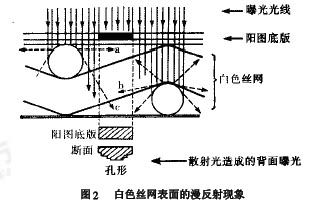3 screen printing decorative screen printing film line number
For ordinary printing, the higher the number of film dots in the film, the smaller the dots formed, the clearer and finer the reproduced images, and the richer the color gradation, but for the silk screen, the number of film dots for the film L It should be smaller than the mesh number of the screen plate. The relationship between the two should generally satisfy: Mc≈ 13L.
For example, if an ordinary decorative painting is copied using the lithography method, dots of 60 to 80 lines/cm are often used for color separation. An ideal replica can be obtained after the printing, and when the screen printing is used, 60 to 80 lines are used. For color separation of 80 lines/cm, screens from 177 to 236 mesh/cm are required to completely reproduce dots, and screen sizes of up to 124 mesh/cm will have a mesh area ratio of less than 30. %, it is difficult for ordinary screen printing inks to miss printing. In order to make the printing run smoothly, a screen with a mesh size of 124 meshes/cm or less should be selected. From this, it is reasonable to calculate that the number of film lines for a stencil screen should be about 41 lines/cm.
4 Screen Color Selection
There are three kinds of screen color: white, yellow, and golden yellow. For a monochrome, coarse text, it doesn't matter what color the screen is chosen for, and for color screen printing, the choice of color is very important. In practical applications, yellow or golden yellow is preferred, rather than white, mainly because the surface of the yellow or gold-yellow screen has a good absorption of the blue-violet light emitted by the printing light source to prevent it from generating diffuse reflection; white silk The surface of the net produces a strong diffuse reflection of the incident light, so that the edges of the dot are not smooth, shiny, or deformed, which affects the sharpness and color gradation of the entire picture [1], as shown in Fig. 2 and Fig. 3 .


5 ink printability deployment
5. 1 Adjustment of Viscosity
The screen printing ink usually purchased has a large viscosity, and should be used according to the characteristics of the printed image, the number of screen meshes, the printing speed, the surface tension of the substrate, and the ink absorption performance, using the diluent (opening water) provided by the manufacturer. Adjustment. If the decorative painting contains a large number of thin lines and dot areas, the ink should be slightly less fluid, the drying speed can be slightly slower; coarse mesh printing, the viscosity should be slightly larger, the drying speed can be slightly faster; substrate surface tension is small, the ink The surface tension should be small; when the ink absorption of the printing surface is strong, the fluidity and surface tension of the ink can be larger.
5. 2 color deployment
In addition to the rule of color mixing, the color deployment should also take into account the effects of the surface properties of the substrates used on the color. Because the efficiency of color reproduction (called the surface efficiency of the substrate) is different for substrates with different absorption properties and surface gloss, as shown in the following formula [3]:
Substrate Surface Efficiency = (100 - A) + PG/2 (2)
In the formula: A is the absorbability of the substrate; PG is the gloss of the substrate. For example, when a decoration painting is printed on a fabric, the actual printed color tends to be darker or darker than the color sample observed on the paper after blending, and even causes a large deviation, mainly due to the strong absorption of the fabric and its Surface efficiency drops. Therefore, in the deployment of ink color when the color should be a little brighter than the desired color. In order to achieve the desired effect.
6 Conclusion
In summary, the following technical points should be mastered when using silk screen printing decorative painting:
1) Select the pictures with more or less hopping colors, simple or abstract patterns, and less rich layers as the manuscript to obtain more ideal reproduction effects.
2) When outputting the film for printing, select the number of lines of 40 lines/cm, and it is not easy to select the number of lines.
3) For the screen printing of ordinary inks, the mesh size of the screen plate is selected to be less than 124 mesh/cm; for screen printing of foamed screen printing inks, the mesh size of the screen plate is selected to be less than 45 mesh/cm.
4) Select a yellow or gold screen to avoid diffuse reflection during exposure exposure to ensure the quality of the graphic.
5) The ink should be thinned during printing, and the surface properties and color rendering properties of the substrate should be taken into account when matching colors.
Author: 1 Wang Lijie, Chen Geng husband 2
(1. Shenzhen Vocational and Technical College; 2. Shenzhen Senior Technical School)
Source: Packaging Engineering, Issue 3, 2005
Kitchen Storage Hardware,Kitchen Larder Pantry Unit,Waste Bins,Hanging Metal Basket
Foshan Gruwill Hardware Products Co., Ltd. , https://www.gwwirebasket.com